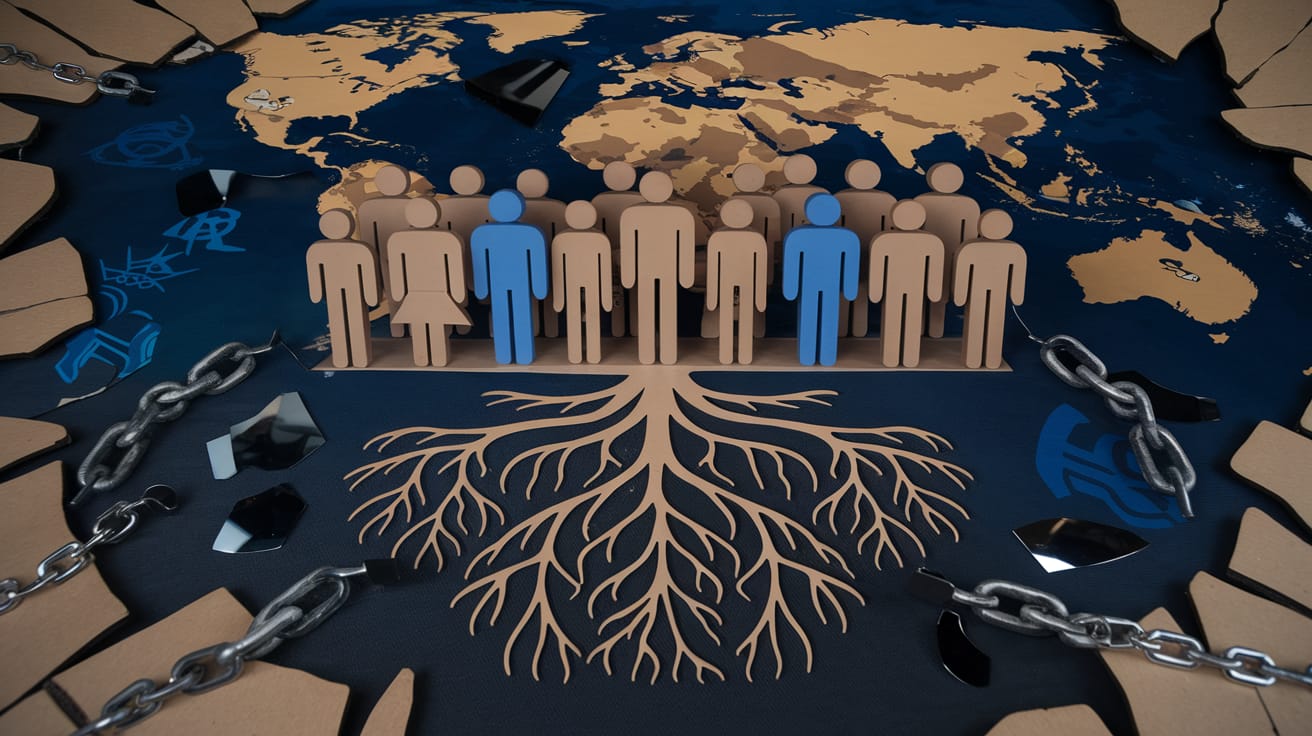Introduction:
In an age where scientific discoveries have revolutionised our understanding of the world, the persistence of racism stands as a stark contradiction. Racism thrives on the idea of inherent differences between human groups, a belief rooted in ignorance and fueled by those seeking to maintain power. But beneath the skin-deep variations that society magnifies, science reveals a profound truth: humans, regardless of their appearance, share 99.9% of the same DNA. The remaining 0.1%, responsible for physical traits like skin colour and hair texture, is trivial in the grand scheme of biology and evolution. These differences are superficial adaptations to environmental factors, not markers of separate races.
This article aims to dismantle the false constructs of race by presenting the undeniable scientific evidence of our shared ancestry. By understanding that the concept of race is a social and political invention, we can expose racism for what it truly is—an outdated tool of oppression—and begin to foster a more unified, equitable society.
1. Race as a Social Construct – Built for Exploitation
The concept of race did not emerge from biological differences, but rather as a tool to justify domination and exploitation. Beginning in the 17th century, European colonial powers constructed the idea of race to rationalise the enslavement of Africans, the displacement of Indigenous peoples, and the extraction of wealth from colonised lands. These distinctions were not based on scientific fact but were invented to dehumanise certain populations and legitimise economic gain.
Racism as a Power Structure: The primary purpose of racism was to create a hierarchy that placed certain groups in positions of authority while relegating others to subordinate roles. By labelling non-European populations as “inferior,” colonizers could excuse atrocities like slavery, genocide, and economic exploitation. The legacy of these systems is still visible today in economic disparities, systemic discrimination, and social hierarchies that persist across the globe.
Perpetuation of Ignorance: Even as science advanced and discredited the idea of race as a biological category, the belief in racial hierarchies persisted. This was not due to mere misunderstanding—it was a deliberate effort to uphold systems of privilege and power. By continuing to frame race as a natural division, those in power maintained control over resources and opportunities, using racism as a tool to justify exclusion and inequality.
2. The Science of Common Ancestry – A Unified Human Family
Modern genetics has unequivocally proven that all humans are far more alike than different. Through the study of DNA, particularly mitochondrial and Y-chromosomal DNA, scientists have traced the origins of all modern humans to a common ancestor in Africa. This shared ancestry challenges the very foundations of racial division.
The Genetic Evidence of Our Common Origin: Mitochondrial DNA, passed from mothers to their children, and Y-chromosomal DNA, inherited through fathers, allow us to trace human lineages back to common ancestors who lived in Africa over 200,000 years ago. As humans migrated out of Africa, they adapted to new environments, developing traits such as lighter skin in less sunny regions and darker skin in equatorial zones. These adaptations were responses to environmental pressures, not indicators of different races.
99.9% Shared DNA: The vast majority of human genetic material is shared. The 0.1% of DNA that varies between individuals accounts for differences like skin colour, eye shape, and hair type. However, these differences have no bearing on intelligence, physical ability, or moral worth. The idea that races represent deep biological divisions is scientifically unfounded and has no place in modern understanding.
The Real Meaning of the 0.1%: This small genetic variation reflects adaptations to different environments rather than biological separations. Traits such as skin pigmentation evolved as a protective measure against ultraviolet radiation in regions with high sun exposure. These adaptations are superficial, yet society has historically magnified them to create false distinctions that uphold racial hierarchies.
3. How Ignorance and Power Fuel Racism
If science has thoroughly debunked the idea of race, why does racism endure? The answer lies in the intersection of ignorance and the deliberate manipulation of power. Racism persists because it serves the interests of those who benefit from maintaining divisions and inequality.
Misinformation and Ignorance: A lack of understanding about human genetics and evolution continues to fuel racist ideologies. Many people, even in the 21st century, cling to outdated notions of racial differences, often because they have not been exposed to accurate information about our shared ancestry. Educational systems, media, and political rhetoric often reinforce these misconceptions, leading to the perpetuation of stereotypes and discrimination.
Racism as a Tool for Control: Racism is not simply a byproduct of ignorance—it is a tool that has been strategically used to maintain social and economic power. By creating divisions based on race, those in control can limit access to resources, opportunities, and political power for certain groups, while preserving privilege for others. This systemic use of race to divide people has deep roots in colonialism and continues to shape societies today.
4. The Solution: Education and Unity
The path to dismantling racism is rooted in education and awareness. Science has already provided the evidence to debunk racist ideologies, but this knowledge must be more widely disseminated and embraced. Through education, we can replace ignorance with understanding and division with unity.
Breaking the Cycle of Ignorance: Educational systems must take the lead in teaching the truth about human genetic diversity and common ancestry. By incorporating lessons on evolution, DNA, and the African origins of humanity into curricula, schools can play a critical role in challenging racist beliefs. Public education campaigns and media outlets should also prioritise correcting misinformation about race, ensuring that accurate information reaches a broad audience.
The Role of Science in Fostering Equality: Science has dismantled the biological basis for race, but its findings must inform public policy, education, and social attitudes. Genetic literacy programs and human rights initiatives should emphasise our shared ancestry and the superficiality of racial differences. By grounding societal change in scientific truth, we can work toward dismantling the systems that perpetuate inequality.
Embracing Our Common Humanity: Ultimately, we must move beyond the false notion of race and embrace our common humanity. The 99.9% of DNA that connects us is far more significant than the minor variations that set us apart. By focusing on our shared ancestry and common goals, we can build a more inclusive and just society—one that values unity over division and equality over hierarchy.
Conclusion: Toward a Unified Future
Racism, as both a social construct and a tool of power, has caused immeasurable harm throughout history. Yet, the very foundation of racism—race itself—has been thoroughly discredited by science. Humans are not divided by biological races; we are one species, with superficial differences shaped by environmental adaptation. The idea that race determines worth, intelligence or ability is not only false but harmful.
As we move forward, the challenge is to ensure that the truth about our shared humanity becomes the guiding principle of our societies. By prioritising education, promoting genetic literacy, and embracing our common ancestry, we can dismantle the power structures that perpetuate racism. The future lies in unity, not division—in recognising that the 99.9% of DNA we share connects us all, regardless of the colour of our skin.
Let us choose knowledge over ignorance and unity over separation, and build a future where equality is not just an aspiration, but a reality for all.

